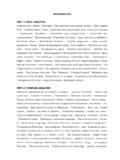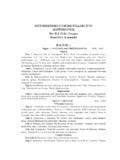Transcription of Riemann wave description of erosional dam-break flows
1 J. Fluid Mech.(2002), , { 2002 Cambridge University PressDOI: Printed in the United Kingdom183 Riemann wave description of erosionaldam-break flowsBy L. FRACCAROLLO1 ANDH. CAPART2y1 Dipartimento di Costruzioni e Tecnologia Avanzata, Universit a di Messina,and Dipartimento di Ingegneria Civile e Ambientale, Universit a degli Studi di Trento, Italy2 Department of Civil Engineering, Universit e catholique de Louvain,and Fonds National de la Recherche Scienti que, Belgium(Received 11 August 2000 and in revised form 12 December 2001)This work examines the sudden erosional flow initiated by the release of a dam-breakwave over a loose sediment bed. Extended shallow-water equations are formulated todescribe the development of the surge. Accounting for bed material inertia, a trans-port layer of nite thickness is introduced, and a sharp interface view of the morpho-dynamic boundary is adopted.}
2 Approximations are sought for an intermediate rangeof wave evolution, in which equilibration of the sediment load can be assumed instan-taneous but momentum loss due to bed friction has not yet been felt. The resultinghomogeneous hyperbolic equations are mathematically tractable using the Riemanntechniques of gas dynamics. dam-break initial conditions give rise to self-similar flowpro les. The wave structure features piecewise constant states, two smoothly variedsimple waves , and a special type of shock: an erosional bore forming at the forefrontof the wave. Pro les are constructed through a semi-analytical procedure, yieldinga geomorphic generalization of the Stoker solution for dam-break waves over rigidbed. For most flow properties, the predictions of the theoretical treatment comparefavourably with experimental tests visualized using particle imaging IntroductionPropagating over a loose sediment substrate, water surges may in some circum-stances set in motion signi cant amounts of bed material.
3 A static granular mediumsaturated with water can be driven to join the flow as a rapidly deforming solid{liquid mixture. Such bulking with eroded material may in turn signi cantly a ect thewave dynamics. Not only does sediment entrainment influence the surge by modi-fying its rheological behaviour and remoulding its underlying topography, but forrapidly varying conditions, the bulking process itself exerts a strong feedback on thewave through incorporation of bed material inertia. erosional transients of this kindare encountered in various conditions of geomorphological and engineering include valley forming floods (Lapointeet al. 1998; Brooks & Lawrence 1999),debris surges in mountainous terrain (Takahashi 1991; Iverson 1997) and sheet-flowsediment entrainment in the coastal surf and swash zones (Asano 1995; Sumeret ).}
4 The present work addresses an extreme occurrence of such phenomena, that is,the erosional flow resulting from the sudden release of a dam-break wave over amobile sediment bed. The con guration considered is shown on gure 1. A horizontalyPresent address: Department of Civil Engineering, National Taiwan University, Fraccarollo and H. Capartzxh0 Figure conditions for the erosional dam-break wave. A horizontal bed of loose wa-ter-saturated sediments extends upstream and downstream of an idealized dam. The water body ofdepthh0retained upstream is instantaneously released at timet= 0 by the dam composed of coarse, cohesionless sediments saturated with water extends onboth sides of an idealized dam. Upstream lies a motionless body of pure water,having depthh0above the sediment bed surface. An intense flow of water and erodedsediment is then released by the instantaneous collapse of the dam.
5 The analysiswill seek to characterize the hydrodynamic and geomorphic e ects which shape theresulting wave on the geomorphic dam-break problem is motivated by practical, theoreticaland experimental considerations. From a practical point of view, rst, geomorphicdam-break waves constitute signi cant hazards in upland valleys. In a number ofcatastrophes of ancient and recent history, floods from dam failures have beenrecorded to induce severe soil movements in the form of flowslides, debris wavesand sediment-laden currents (Costa & Schuster 1988). A well-documented recentevent is the Lake Ha! Ha! break-out flood which occurred in 1996 in the Saguenayregion of Qu ebec (Lapointeet al. 1998; Brooks & Lawrence 1999). Under heavyrains, lake waters overtopped and swept away a small saddle dyke 1 m in height,then went on to scour a 14 m thick layer of underlying soil, incising a deep channelupstream and downstream of the dyke site ( gure 2).
6 Beyond these near- eld e ects,the flood wave released by the new outlet caused extensive erosion and damage inthe downstream valley, locally widening the river course by up to 280 m. Geomorphice ects were strong enough to preclude application of purely hydrodynamic floodrouteing procedures (INRS-Eau 1997). Although the idealized dam con guration of gure 1 constitutes only a very rough analogue of the Ha! Ha! cut-away dyke, it willbe seen to lead to similar near- eld geomorphic e ects. The analysis will also pointout some inherent limitations of hydrodynamic or alluvial hydraulic descriptions ofsuch extreme second motivation is theoretical. The geomorphic dam-break problem con-stitutes a particularly transparent example of more general processes. For the samereason, the rigid bed dam-break problem has become a touchstone of shallow-watertheory.
7 The Ritter (1892) and Stoker (1957) analytical solutions for pure water dam-break waves clarify the hydrodynamics of rapid transients. They are also extensivelyused for the development and validation of computational schemes ( Fennema &Chaudhry 1987; Glaister 1988; Alcrudo, Garcia-Navarro & Saviron 1992; Toro 1992;Fraccarollo & Toro 1995). Under certain assumptions, the erosional dam-break waveis shown in the present work to be amenable to a similar analytical treatment. ThisRiemann wave description of erosional dam-break flows185 Figure Lake Ha! Ha! break-out flood, Saguenay, Qu ebec. View of the outlet channelscoured by flood waters after overtopping of a small saddle dyke. Original position of the dykeshown in white. The drained lake is shown in the background. Heavy scour progressed bothupstream and downstream of the failed dyke (Brooks & Lawrence 1999).
8 Photograph courtesy ofDr G. R. Brooks, Geological Survey of the Stoker solution, it is hoped, will prove equally helpful in gainingphysical insight and guiding computational e third motivation is experimental. The con guration shown in gure 1 isparticularly simple to implement in the laboratory. The chief obstacle to erosionaldam-break flow experiments lies in their rapid character and high-sensitivity tointruding elements (such as sediment samplers or probes). The burden is thus shiftedto measurement techniques. Recent developments in imaging methods (for a review offluid mechanics applications, see Adrian 1991) provide new solutions to this were used by Capart and Young (1998) to obtain detailed measurements ofmobile bed dam-break experiments performed with very light grains (barely heavierthan water). In the present work, we present some new experiments carried out withdenser sediment material and improved imaging Fraccarollo and H.
9 CapartSevere erosional floods are well documented in the geomorphological literature(Clague, Evans & Blown 1985; Gallino & Pierson 1985; Jarrett & Costa 1986;Waythomaset al. 1996; Benito, Grodek & Enzel 1998). To date, fewer studies havebeen devoted to the mechanics of such processes, prompting this assessment by Costa& Schuster (1988): `This problem of bulking and debulking of flood flows representa di cult unsolved problem in sediment transport today, and its consequences forhazard evaluation are signi cant.' An early laboratory study was carried out byChen & Simons (1979), who described qualitatively the e ects of a dam-breakflow on an erodible valley. Laboratory experiments focusing on idealized conditionswere performed by Capart & Young (1998), and Leal & Ferreira (1999). Thesetwo works also include computational simulations, obtained by extending shallow-water solvers to mobile bed conditions.
10 The equations solved were not establishedin a systematic fashion, however, and were not analysed in depth from a moremathematical what follows, we will lay out an appropriate set of constitutive assumptionsand construct a tractable mathematical description of sudden erosional flows. Theproposed view departs from classical alluvial hydraulic treatments ( de Vries 1965;Holly & Rahuel 1990; Zanr e & Needham 1994; Saiedi 1997) in that the thicknessof the sediment transport layer as well as its inertia cannot be neglected. A discretesystem approach (Abbott 1979) is adopted, whereby the flow in the vertical plane isapproximated by regions of homogenous properties separated by sharp interfaces. Adiscontinuity of particular interest is the underlying bed boundary, which we treat asa phase interface across which the saturated sediment material undergoes a transitionfrom solid- to fluid-like behaviour.








